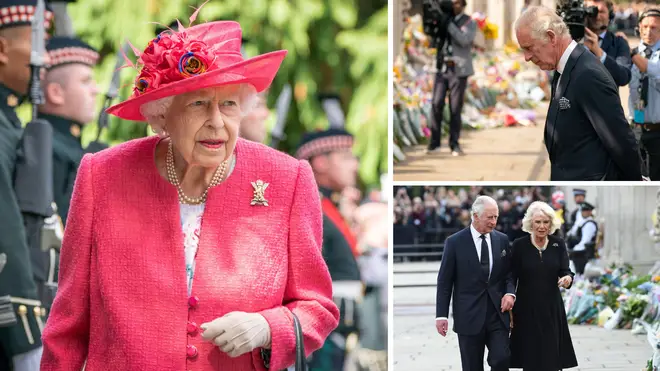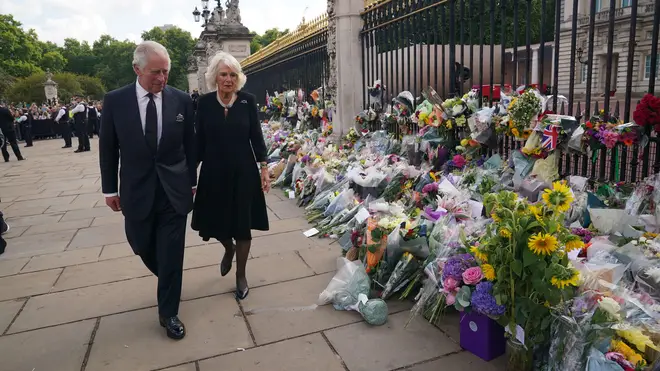
Shelagh Fogarty 1pm - 4pm
9 September 2022, 16:02

Queen Elizabeth II's death on Thursday triggered Operation London Bridge, but how will Britain mourn the monarch's death?
King Charles arrived in London after leaving Balmoral and flying to the capital from Aberdeen.
He will have his first audience as monarch with Prime Minister Liz Truss later on Friday afternoon.
Charles will also meet the Earl Marshal - the Duke of Norfolk - who is in charge of the accession and the Queen's funeral, to approve the carefully choreographed schedule for the coming days.
At 6pm, the King will make a televised address to the nation, which he is due to pre-record. He will pay tribute to the Queen and pledge his duty to his service as the new sovereign.
Also at 6pm a public service of remembrance attended by the Prime Minister and senior ministers will be held at St Paul's Cathedral.
Members of the public will be directed to leave floral tributes at Royal Residences including dedicated sites The Green Park and Hyde Park as well as Cambridge Gate on the Long Walk at Windsor Castle, at the Norwich Gates at the Sandringham Estate and at the Main Gate of Balmoral Castle.
Flowers can also be laid at the Wardens at the entrance to The Queen’s Gallery at the Palace of Holyroodhouse and on the Castle Forecourt, in front of the main gates at Hillsborough Castle.

The new King will be formally proclaimed monarch at a historic Accession Council in the State Apartments of St James's Palace at 10am on Saturday.
A Principal Proclamation will be read in public for the first time by the Garter King of Arms in the open air from the balcony overlooking Friary Court at St James's an hour later at 11am.
It will be followed by a flurry of Proclamations around the country, with the second one at City of London at the Royal Exchange at midday on Saturday.
In recognition of the new Sovereign, union flags will be flown at full-mast from the time of the Principal Proclamation at St James's Palace until one hour after the Proclamations in Scotland, Northern Ireland and Wales on Sunday.
Historically, the entire Privy Council is summoned to the Accession Council to oversee the formal proclamation of a new monarch.
But with the number of privy counsellors - who are lifetime members and mostly past and present politicians - now standing at more than 700, restrictions have been put in place.
Just 200 will be summoned, and those cut will be asked to enter an annual ballot for a few remaining seats, with the decision prompting a row over the lack of consultation and the loss of the key duty.

What happens after the Queen dies?
The Queen's coffin is expected to be taken by road to the Palace of Holyroodhouse in Edinburgh.
Further Proclamations will take place in Scotland, Northern Ireland and Wales at midday on Sunday.
Flags will return to half-mast in mourning for the death of Queen following the Proclamations.
Procession is expected along Royal Mile to St Giles' Cathedral. Service and the Vigil of the Princes by members of the royal family.
The public may get the chance to file past the Queen's coffin at a mini lying in state in St Giles'.
The House of Commons and the House of Lords are expected to come together in Westminster for a Motion of Condolence, which the King could attend.
After leaving England and visiting Scotland, Charles will at some stage travel to the other countries of the UK - Wales and Northern Ireland - known as Operation Spring Tide.
Queen's coffin expected to be flown to London. Expected to be at rest at Buckingham Palace.
A rehearsal for the procession of the coffin from Buckingham Palace to the Palace of Westminster takes place.
Read more: Grieving Harry consoles airport worker before flying back from Balmoral after Queen's death
The Queen's lying in state is expected to begin in Westminster Hall - Operation Marquee - following a ceremonial procession through London.
It will last four full days.
The Archbishop of Canterbury will conduct a short service following the coffin's arrival.Hundreds of thousands of people will file past the coffin on its catafalque and pay their respects, just as they did for the Queen Mother's lying in state in 2002.
The management of the queues outside is Operation Feather.
Senior royals are also expected to pay their own moving tribute, standing guard at some stage around the coffin - the tradition known as the Vigil of the Princes.
Lying in state continues and a rehearsal is likely to take place for the state funeral procession.
Lying in state continues, ending on Saturday September 17. Heads of state begin to arrive for the funeral.
The Queen's state funeral is expected take place at Westminster Abbey in central London.
It has not been revealed yet when Her Majesty will be laid to rest - but it's expected to be in around 10 days' time (Monday 19).
The original plans are for the Queen's coffin to process on a gun carriage to the abbey, pulled by naval ratings - sailors - using ropes rather than horses.
Senior members of the family are expected to poignantly follow behind - just like they did for the funeral of Diana, Princess of Wales and the Duke of Edinburgh.
The military will line the streets and also join the procession.Heads of state, prime ministers and presidents, European royals and key figures from public life will be invited to gather in the abbey, which can hold a congregation of 2,000.
The service will be televised, and a national two minutes' silence is expected to be held.
The same day as the funeral, the Queen's coffin will be taken to St George's Chapel at Windsor Castle for a televised committal service.
Later in the evening, there will be a private interment service with senior members of the royal family.
The Queen's final resting place will be the King George VI memorial chapel, an annex to the main chapel - where her mother and father were buried, along with the ashes of her sister, Princess Margaret.
Philip's coffin will move from the Royal Vault to the memorial chapel to join the Queen's.